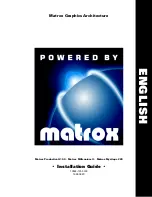
Hardware Connections
3.4 Common Studio Setups
This section describes typical studio setups using the AES16
e
.
3.4.1 External A/D and D/A with Word-clock
The figure below illustrates the connection of an eight-channel A/D converter and an eight-channel D/A
converter to I/O Port A of the AES16
e
. This setup uses only half of the available I/O on the AES16
e
.
Additional converters can be connected to I/O Port B to provide up to 16 channels of A/D and D/A
conversion.
Also shown is the use of the word-clock output of the A/D as the system clock. This signal drives the word-
clock input of the AES16
e
, which is available on the CLOCK BNC connector on the breakout cable
attached to I/O Port A. Note: this connector is a word-clock
output
when the cable is attached to I/O Port
B. Also, a separate word-clock connection is not always required since any of the four AES inputs
connected to I/O Port A can be used as word-clock sources.
AES16e Clock Settings
To select the external clock input as the sample clock source for the AES16
e
, set the SAMPLE CLOCK
SOURCE in the Adapter window of the Lynx Mixer to “External”.
External Equipment Clock Settings
Since the internal clock of the A/D converter is the clock master in this setup, change its clock setting to
select its internal clock. Set the D/A converter to slave to one of its digital inputs. Alternatively, another
word-clock signal from the A/D or from I/O Port B of the AES16
e
could drive the word-clock input of the
D/A. In this case, the clock source of the D/A should be set to the appropriate setting for external word-
clock.
AES16e User Manual
Page 26
















































